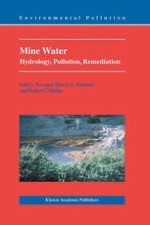2002 | OriginalPaper | Chapter
Passive Treatment of Polluted Mine Waters
Authors : Paul L. Younger, Steven A. Banwart, Robert S. Hedin
Published in: Mine Water
Publisher: Springer Netherlands
Included in: Professional Book Archive
Activate our intelligent search to find suitable subject content or patents.
Select sections of text to find matching patents with Artificial Intelligence. powered by
Select sections of text to find additional relevant content using AI-assisted search. powered by
As contaminated mine waters flow into and through receiving systems (streams, rivers, wetlands and lakes), their toxic characteristics commonly decrease. Many studies (e.g. Tuttle
et al.
, 1969, Wieder and Lang 1982; Huntsman 1978; Stark
et al.
, 1990; Herlihy and Mills 1985) have shown that this amelioration in quality occurs as a result of:
natural chemical and biological reactions and
dilution with uncontaminated waters.
The net result is that potentially ecotoxic metals are removed from solution, and therefore placed largely out of harm’s reach, by precipitation as hydroxide, oxide, sulfate, sulfide and (less commonly) carbonate minerals. Acidity is neutralized by:
mixing with waters which already possess alkalinity and/or
liberation of alkalinity from minerals (by
in situ
dissolution of pre-existing carbonate minerals, especially calcite, but to a lesser extent dolomite also) and/or
generation of alkalinity from organic matter by heterotrophic microbial processes. During the last 15 years, the possibility that natural ameliorative processes might be harnessed in mine water treatment systems has developed into a practice referred to as
passive treatment
. Although the term ‘passive treatment’ has been in use for almost a decade at the time of writing (e.g. Cohen and Staub, 1992), formal definitions of the term are not easy to find. The following definition of the term was coined by William Pulles of South Africa, and subsequently formally adopted by the European Union’s PIRAMID R&D project (www.piramid.org):
“Passive treatment is the deliberate improvement of water quality using only naturally-available energy sources (e.g. gravity, microbial metabolic energy, photosynthesis), in systems which require only infrequent (albeit regular) maintenance in order to operate effectively over the entire system design life”
